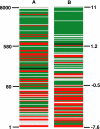Brain-specific proteins decline in the cerebrospinal fluid of humans with Huntington disease
- PMID: 18984577
- PMCID: PMC2649809
- DOI: 10.1074/mcp.M800231-MCP200
Brain-specific proteins decline in the cerebrospinal fluid of humans with Huntington disease
Abstract
We integrated five sets of proteomics data profiling the constituents of cerebrospinal fluid (CSF) derived from Huntington disease (HD)-affected and -unaffected individuals with genomics data profiling various human and mouse tissues, including the human HD brain. Based on an integrated analysis, we found that brain-specific proteins are 1.8 times more likely to be observed in CSF than in plasma, that brain-specific proteins tend to decrease in HD CSF compared with unaffected CSF, and that 81% of brain-specific proteins have quantitative changes concordant with transcriptional changes identified in different regions of HD brain. The proteins found to increase in HD CSF tend to be liver-associated. These protein changes are consistent with neurodegeneration, microgliosis, and astrocytosis known to occur in HD. We also discuss concordance between laboratories and find that ratios of individual proteins can vary greatly, but the overall trends with respect to brain or liver specificity were consistent. Concordance is highest between the two laboratories observing the largest numbers of proteins.
Figures



Similar articles
-
The influence of ageing in the cerebrospinal fluid concentrations of proteins that are derived from the choroid plexus, brain, and plasma.Exp Gerontol. 2012 Apr;47(4):323-8. doi: 10.1016/j.exger.2012.01.008. Exp Gerontol. 2012. PMID: 22532968
-
Regional brain and cerebrospinal fluid quinolinic acid concentrations in Huntington's disease.Neurosci Lett. 1991 Jan 28;122(2):265-9. doi: 10.1016/0304-3940(91)90874-s. Neurosci Lett. 1991. PMID: 1827518
-
An integrated workflow for multiplex CSF proteomics and peptidomics-identification of candidate cerebrospinal fluid biomarkers of Alzheimer's disease.J Proteome Res. 2015 Feb 6;14(2):654-63. doi: 10.1021/pr501076j. Epub 2014 Dec 22. J Proteome Res. 2015. PMID: 25490617
-
Major depressive disorder: insight into candidate cerebrospinal fluid protein biomarkers from proteomics studies.Expert Rev Proteomics. 2017 Jun;14(6):499-514. doi: 10.1080/14789450.2017.1336435. Expert Rev Proteomics. 2017. PMID: 28562112 Review.
-
Proteomic studies in the discovery of cerebrospinal fluid biomarkers for amyotrophic lateral sclerosis.Expert Rev Proteomics. 2017 Sep;14(9):769-777. doi: 10.1080/14789450.2017.1365602. Epub 2017 Aug 14. Expert Rev Proteomics. 2017. PMID: 28799854 Review.
Cited by
-
Proteomic Profiling of Extracellular Vesicles Derived from Cerebrospinal Fluid of Alzheimer's Disease Patients: A Pilot Study.Cells. 2020 Aug 25;9(9):1959. doi: 10.3390/cells9091959. Cells. 2020. PMID: 32854315 Free PMC article.
-
Neuroinflammation in Huntington's disease: From animal models to clinical therapeutics.Front Immunol. 2022 Dec 22;13:1088124. doi: 10.3389/fimmu.2022.1088124. eCollection 2022. Front Immunol. 2022. PMID: 36618375 Free PMC article. Review.
-
Cerebrospinal fluid biomarkers for assessing Huntington disease onset and severity.Brain Commun. 2022 Nov 25;4(6):fcac309. doi: 10.1093/braincomms/fcac309. eCollection 2022. Brain Commun. 2022. PMID: 36523269 Free PMC article.
-
CSF-Targeted Proteomics Indicate Amyloid-Beta Ratios in Patients with Alzheimer's Dementia Spectrum.Int J Alzheimers Dis. 2023 Feb 6;2023:5336273. doi: 10.1155/2023/5336273. eCollection 2023. Int J Alzheimers Dis. 2023. PMID: 36793451 Free PMC article.
-
Alterations in the tyrosine and phenylalanine pathways revealed by biochemical profiling in cerebrospinal fluid of Huntington's disease subjects.Sci Rep. 2019 Mar 11;9(1):4129. doi: 10.1038/s41598-019-40186-5. Sci Rep. 2019. PMID: 30858393 Free PMC article.
References
-
- The Huntington's Disease Collaborative Research Group ( 1993) A novel gene containing a trinucleotide repeat that is expanded and unstable on Huntington's disease chromosomes. Cell 72, 971–983 - PubMed
-
- Hodges, A., Strand, A. D., Aragaki, A. K., Kuhn, A., Sengstag, T., Hughes, G., Elliston, L. A., Hartog, C., Goldstein, D. R., Thu, D., Hollingsworth, Z. R., Collin, F., Synek, B., Holmans, P. A., Young, A. B., Wexler, N. S., Delorenzi, M., Kooperberg, C., Augood, S. J., Faull, R. L., Olson, J. M., Jones, L., and Luthi-Carter, R. ( 2006) Regional and cellular gene expression changes in human Huntington's disease brain. Hum. Mol. Genet. 15, 965–977 - PubMed
-
- Chan, E. Y., Luthi-Carter, R., Strand, A., Solano, S. M., Hanson, S. A., DeJohn, M. M., Kooperberg, C., Chase, K. O., DiFiglia, M., Young, A. B., Leavitt, B. R., Cha, J. H., Aronin, N., Hayden, M. R., and Olson, J. M. ( 2002) Increased huntingtin protein length reduces the number of polyglutamine-induced gene expression changes in mouse models of Huntington's disease. Hum. Mol. Genet. 11, 1939–1951 - PubMed
-
- Strand, A. D., Aragaki, A. K., Shaw, D., Bird, T., Holton, J., Turner, C., Tapscott, S. J., Tabrizi, S. J., Schapira, A. H., Kooperberg, C., and Olson, J. M. ( 2005) Gene expression in Huntington's disease skeletal muscle: a potential biomarker. Hum. Mol. Genet. 14, 1863–1876 - PubMed
-
- Luthi-Carter, R., Hanson, S. A., Strand, A. D., Bergstrom, D. A., Chun, W., Peters, N. L., Woods, A. M., Chan, E. Y., Kooperberg, C., Krainc, D., Young, A. B., Tapscott, S. J., and Olson, J. M. ( 2002) Dysregulation of gene expression in the R6/2 model of polyglutamine disease: parallel changes in muscle and brain. Hum. Mol. Genet. 11, 1911–1926 - PubMed
Publication types
MeSH terms
Substances
LinkOut - more resources
Full Text Sources
Medical

